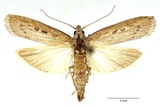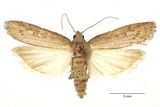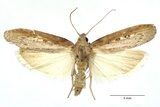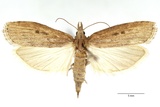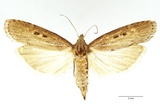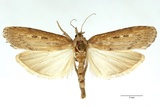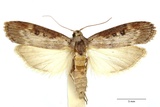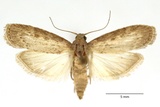Lamoria zelleri (De Joannis, 1932) Species
Last modified: Nov. 20, 2025, 8:52 p.m.
A rare species in Flanders, more frequently observed in the sandy areas of the northwest of the country, especially at the sea coast.
Details
- Classification
- Family: Pyralidae > Subfamily: Galleriinae > Tribus: Tirathabini > Genus: Lamoria > Species: Lamoria zelleri
- Vernacular names
- Duinmosmot (NL), Twin-spot Honey Moth, Sandhill Double-spot (EN), Zellers Wachsmotte (DE)
- Synonyms
- Lamoria bipunctanus (Zeller, 1848)
- First mention in Belgium
- De Fré Ch. 1858. Catalogue des Microlépidoptères de la Belgique. — Annales de la Société entomologique belge 2: 45–162. On page 103 (as M.[elissoblaptes] Anellus. W. V.; Dup.). view page
- Status
-
Native
Distribution
Imago
Wingspan male 20–24 mm, female 26–37 mm. Can be confused with Aphomia anella, a species that was previously claimed for Belgium, but by checking the genitalia and wing venation of the available collected specimens, the species has now been removed from the Belgian list.
Lamoria zelleri is a variable species in size and coloration of wings, it is desirable to check the genitals or the wing venation to discover Lamoria anella. Wing venation M2 (M1 + M2 fused together) is absent in Lamoria zelleri and well developed in Lamoria anella.
Bionomics
The larva lives in a vertical silken tube extending about 10 cm into the sand. It hibernates and pupates in the silken tube below the surface.
The moth hides in vegetation during daytime and are active just after dark and again in early morning sun. They come to light, males more frequently than females.
Flight periods
The adults fly from mid-June till mid-September. Most observations during July.
Observed on
- Host plant (species):
- Brachythecium albicans
- Substrates:
- Mosses
The larva lives on the moss Brachythecium albicans. Also reported on grasses like Ammophila and herbs like Thymus, Trifolium, Hieracium, Euphorbia and in bumblebee (Bombus)and was (Vespula) nests. It feeds on vegetal and insects detritius.
Habitat
It favours dry habitats, coastal places, rural areas, scrub land and sandy areas.
